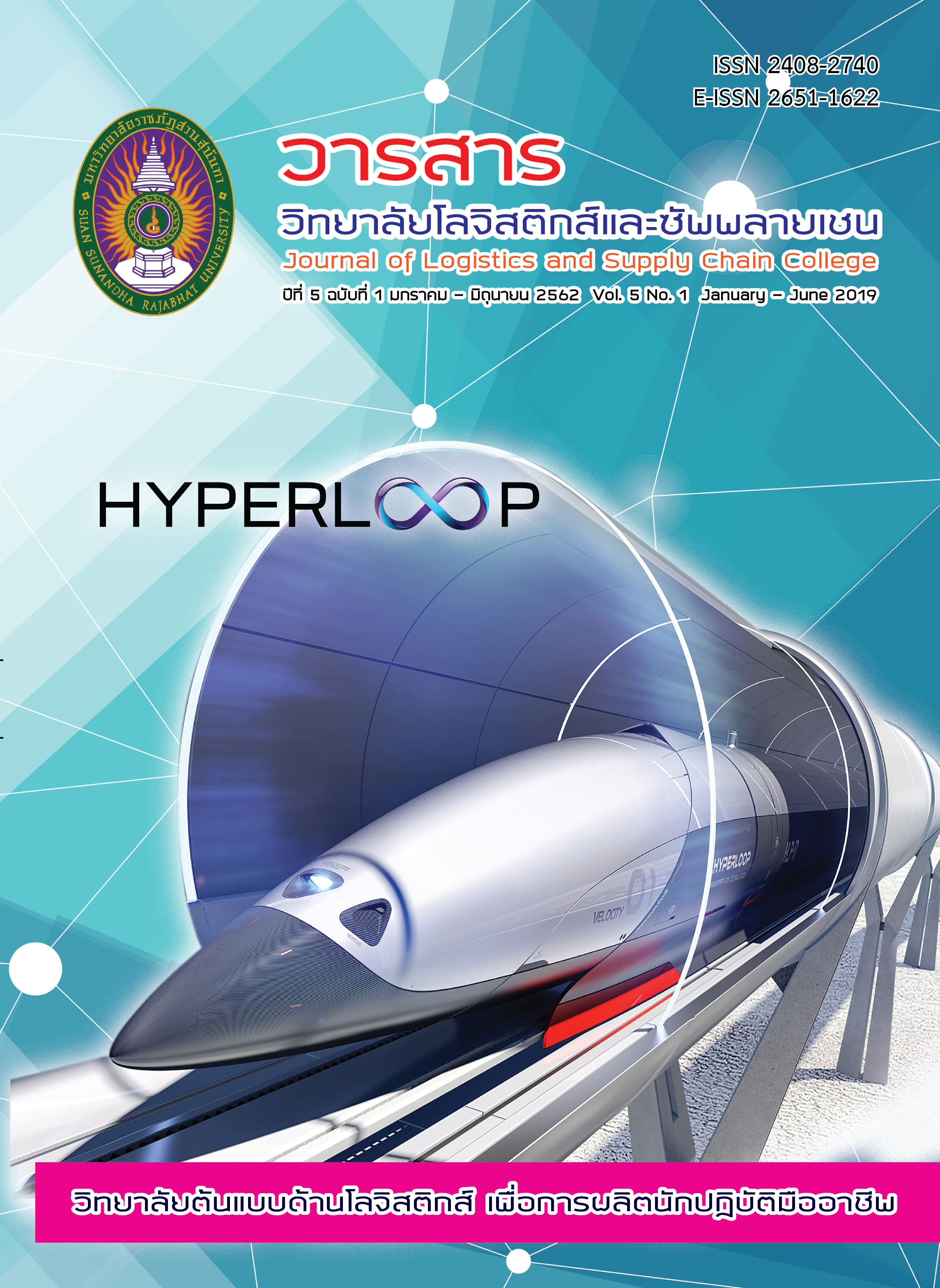Supply Chain Performance Measurement: Case of A-Type One Tambon One Product Industry in Chonburi Province
Abstract
The purpose of research work is twofold: 1) to find appropriate key performance indicators for OTOP business in Chonburi province and 2) to evaluate the performance of the A-TYPE OTOP Industry in Chonburi province and to compare with the national standard dimension of key performance indicators in the food industry. The methodology employed in this research work was the mixed research methods comprising, namely observation and strucktured interview. The sample of this research was 47 A-TYPE OTOP owner from 5 industires that consist of 1) food, 2) beverage, 3) fabric and apparel, 4) apparatus and decoration and 5) herb (non food) and the number of respondent was 30. Descriptive statistics was employed for data analysis. The results shown that (1) it was found that there are 18 key performance indicators (KPIs) that is suitable for the A-TYPE OTOP Industry in Chonburi province (2) the result found that the A-TYPE OTOP Industry in Chonburi has high cost dimension performance, particulry ratio of warehousing cost per sale that the average performance score was higher than 20% per sale and (3) with regards to the composite index, the A-TYPE OTOP food Industry has superiority over the national food industry. However, the former has the imbalance operations, namely, the cost dimension output of the A-TYPE OTOP food Industry was in “somewhat inferior” level.
References
กรมการพัฒนาชุมชน. (2558). คู่มือการดําเนินงานผู้ผลิต ผู้ประกอบการโอทอปรายใหม่ ประจําปี 2558. Retrieved, from https://www.cep.cdd.go.th/news/document/contents.pdf
กองส่งเสริมธุรกิจชุมชน .(2560). พาณิชย์ยกระดับมาตรฐานสินค้าโอทอปจากภูมิปัญญาไทย เชื่อมการท่องเที่ยว หวังเพิ่มรายได้สู่ชุมชน. ค้นเมื่อ https://dbd.go.th/dbdweb56/mobile/news_view.php?nid=469404975.
ปิยาภรณ์ มาลี. (2558). การประยุกต์ใช้ตัวชี้วัดประสิทธิภาพโซ่อุปทานกับผู้ประกอบการโอทอปในจังหวัดชลบุรี. วิทยานิพนธ์ มหาบัณฑิต คณะโลจิสติกส์ มหาวิทยาลัยบูรพา.
ปิยาภรณ์ มาลี และ ปิยะวัฒน์ ชนินทร์ตระกูล. (2557). การทดสอบเครื่องมือเบื้องต้นในตัวชี้วัดประสิทธิภาพโซ่อุปทาน: กรณีศึกษาผู้ประกอบการโอทอปประเภทอาหารในจังหวัดชลบุรี. กรุงเทพมหานคร:รายงานการประชุมสัมมนาเชิงวิชาการประจำปีด้านการจัดการโลจิสติกส์และโซ่อุปทาน ครั้งที่ 14.
ทวีศักดิ์ เทพพิทักษ์ 2550. การจัดการโลจิสติกส์และการเพิ่มขีดความสามารถในการแข่งขันสำหรับผลิตภัณฑ์ OTOP ในจังหวัดชลบุรี. กรุงเทพมหานคร: สำนักงานกองทุนสนับสนุนการวิจัย.
รุธิร์ พนมยงค์. 2559. ตำราการวัดประสิทธิภาพด้านจัดการโลจิสติกส์และโซ่อุปทาน. กรุงเทพฯ: จรัลสนิทวงศ์การพิมพ์.
วรกันต์ จารุพพัฒน์. (2548). การวัดประสิทธิภาพกลุ่มวิสาหกิจชุมชนสินค้าผ้าพื้นเมืองในโครงการ "หนึ่งตำบลหนึ่งผลิตภัณฑ์". วิทยานิพนธ์ มหาบัณฑิต คณะเศรษฐศาสตร์ มหาวิทยาลัยธรรมศาสตร์.
สำนักงานพัฒนาชุมชนจังหวัดชลบุรี. (2556). แนวทางการดําเนินงาน OTOP จังหวัดชลบุรี ปี 2557.
สำนักโลจิสติกส์ กรมอุตสาหกรรมพื้นฐานและการเหมืองแร่. (2557). รายงานฉบับสมบูรณ์ (Final Report) โครงการศูนย์บริการข้อมูลโลจิสติกส์ (Logistics Service Information Center: LSIC).
สุทธิวรรณ สังวร.( 2555). การออกแบบโซ่อุปทานของหนึ่งตำบลหนึ่งผลิตภัณฑ์: กรณีศึกษาปลาส้มฟัก อำเภอบ้านหมี่ จังหวัดลพบุรี. วิทยานิพนธ์ มหาบัณฑิต คณะวิศวกรรมศาสตร์ มหาวิทยาลัยธรรมศาสตร์.
Banomyong, R., Basnet, C., Childerhouse, P., Deakins, E., Disney, S.M., Naim, M.M., & Towill, D.R. 2005. Internationalising the quick scan audit methodology. Salerno: the 18th International Conference on Production Research Proceedings.
Banamyong, R. & Supatn, N. (2011). Developing a supply chain performance tool for SMEs in Thailand. Supply Chain Management: An International Journal, 16(1), 20-31.
Chan, F.T.S., & Qi, H.J. Z2003a). Feasibility of performance measurement system for supply chain: A process-based approach and measures. Integrated Manufacturing Systems, 14(3), 179 - 190.
Chan, F.T.S., & Qi, H.J. (2003b). An innovative performance measurement method for supply chain management. Supply Chain Management: An International Journal, 8(3), 209 - 223.
Charan, P., Shankar, R., & Baisya, R. K. (2008). Analysis of interactions among the variables of supply chain performance measurement system implementation.”Business Process Management Journal, 14(4), 512 - 529.
CSCMP. (2004). Supply Chain Management Process Standards. Oak Brook, IL.: Council of Supply Chain Management Professionals.
Foggin, J., Mentzer, J. and Monroe, C. 2004. A supply chain diagnostic tool. International Journal of Physical Distribution & Logistics Management, 34(10), 827-55.
Grant, D. B., Lambert, D., Stock, J. R., & Ellram, L. M. (2006). Fundamentals of Logistics Management. London: McGraw-Hill Higher Education.
Lambert, D. M., & Pohlen, T. L. (2001). Supply chain metrics. The International Journal of Logistics Management, 12(1), 1-19.
Naim, M. M., Childerhouse, P., Disney, S. M., & Towill, D. R. (2002). A supply chain diagnostic methodology: determining the vector of change. Computers & Industrial Engineering, 43(1–2), 135-157.
Saunders, M., Lewis, P., & Thornhill, A. (2007). Research Methods for Business Students (4th ed.). Harlow: Financial Times/Prentice Hall.
Sinha, R. K., & Babu, A. S. (1998). Quality of customer service in supply chain system: a diagnostic study. Internation Journal of Quality & Reliability Management, 15(8/9), 844-859.
Shepherd, C., & Günter, H. (2006). Measuring supply chain performance: current research and future directions. International Journal of Productivity and Performance Management, 55 (3/4), 242 - 258.



